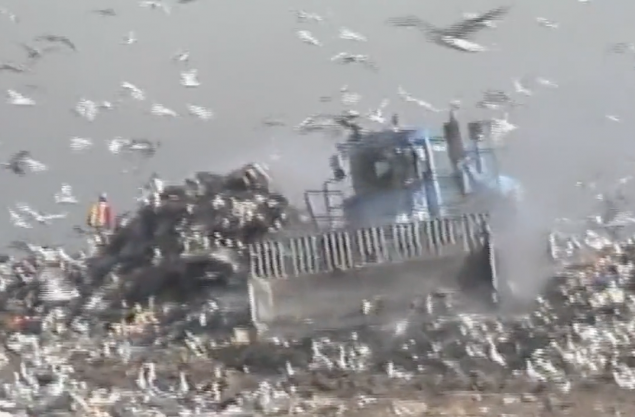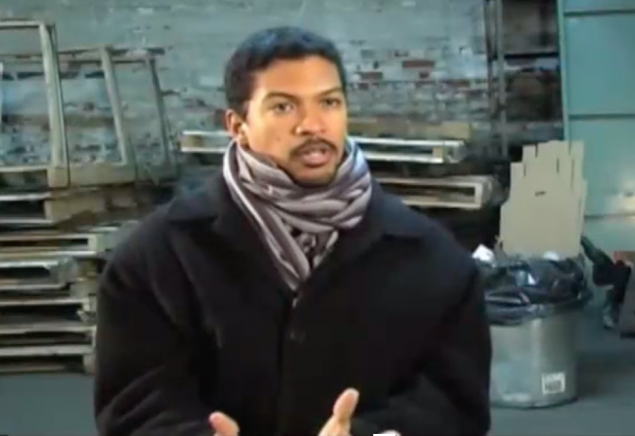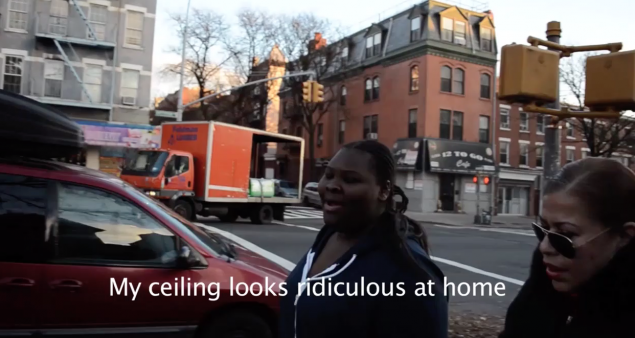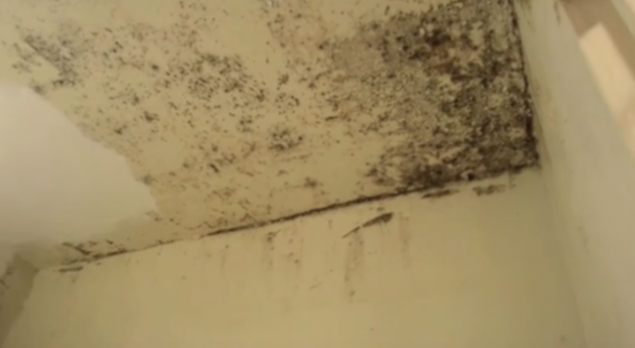Link to the JSE April 2020 Ecomedia Literacy Table of Contents [1]
Goodman PDF [2]
Thirty years ago, high school students in an after-school workshop made a short documentary sounding the alarm about the growing environmental crisis of garbage pollution in New York City. They wondered where the garbage we throw out all goes, and ended up bringing their cameras atop the man-made mountain called Fresh Kills, the largest landfill in the world — where at its peak barges brought as much as 29,000 tons of the city’s garbage every day (New York City Department of Parks and Recreation, 2019). Before New York City began mandatory recycling, the students used their film Trash Thy Neighbor (Educational Video Center, 1990) to make audiences aware of community buy back recycling centers, and with music and humor they showed how to recycle and reuse what they buy.
Click here [4] to view a clip from Trash Thy Neighbor
When the landfill was finally closed a decade later, the city’s solution to the unsustainable flood of residential garbage was to ship most of it into low-income communities of color for processing by privately operated transfer stations. Another student crew then brought their cameras to document the high rates of asthma among residents in the South Bronx, who were suffering from excessive diesel exhaust fumes from transfer sanitation trucks and nearby industrial and highway traffic. The South Bronx community endured a relentless 2 to 3 truck trips per minute hauling garbage in and out of the residential streets to 9 transfer stations in the area and was also reported to have the highest age-adjusted asthma death rates “by far” among all counties in the state (Crean, 2015). In their documentary, Shame on You! That Can Be Reused! (Educational Video Center, 2007) Bronx youth and adult activists spoke out against the systemic dumping on poor communities of color and connected their struggle for sustainable environmental justice with the struggle for political power, racial equity, and the health and wellbeing of the community.
Click here [6] to view a clip from Shame on You! That Can Be Reused!
The students making these documentaries were all participants in after-school youth media programs run by the nonprofit Educational Video Center (EVC). Since 1984, thousands of New York City high school and middle school students at EVC have gone through the transformative experience of collaboratively researching, shooting, and editing documentaries about urgent social issues in their schools and communities. Through the intensive experience of creating these projects, they develop a range of civic, critical media literacy, and documentary production skills. Most importantly, they learn to critically understand the systemic obstacles they face and make their voices heard advocating for change.
What makes this a transformative pedagogy is that it connects students’ learning to their lives and to the possibility of changing the world around them. Inspired by Paulo Freire’s (1970) radical pedagogy, the documentary project places students’ experiences, questions, and community problems at the center of their learning. They learn to “read the world” around them, and see that while climate change is causing catastrophic crises on a global scale, environmental problems don’t only impact far off parts of the world like the Amazon rainforest. They are also happening locally, here at home in our urban, rural and suburban communities. They learn to take notice, question, and defamiliarize the familiar often overlooked conditions in both their indoor and outdoor environment — whether it’s the overflowing garbage in the streets, toxic mold in apartments, or the diesel truck fumes in the air.
This stance of being student centered and culturally responsive, of teaching to and through students’ strengths and interests as Geneva Gay (2010) describes it, is put into practice when students choose the subject of their documentary inquiry. This begins at EVC when the teacher guides students through the process of brainstorming, discussing, pitching stories, narrowing down and reaching consensus on the critical problem they experience in their everyday lives that they want to raise awareness about and change. This gives them a greater sense of ownership over their learning and practice in democratic decision making.
As students collaboratively pursue their questions, they engage in an inquiry process that democratizes research and knowledge creation. They learn to value and tap into community knowledge and expertise and so may interview each other, their family members, and community advocates, as well as more traditional “experts” such as college professors and political leaders. Informed by the methodology of participatory action research (Cammarota & Fine, 2008; Horton, 1990), their documentary embodies the idea that problems are best solved through research that is done with, by and for the people from the community who experience them. Collecting fact-based evidence of injustice is linked to actions that can remedy it. Students can become environmental and public health advocates learning to test and monitor air and water quality and document their findings. (See the accompanying article about a partnership bringing together youth from New York City and Tennessee who document and test water contaminated by strip mining in their Appalachian community.) They develop a greater sense of their own agency and civic empowerment when they not only use the power of media to shine a spotlight on the root causes of environmental problems but also partner with local environmental justice groups to speak out and take action on the changes that are needed to create a more healthy and sustainable environment.
An EVC class collaboration with a Harlem environmental justice organization exemplifies how a student-community partnership can amplify the impact of student media projects (Goodman, 2018). Their documentary on the epidemic of lead poisoning and toxic mold in New York City’s 400,000 resident public housing system focuses on the struggles of one of the EVC filmmakers who suffers from asthma and chronicles in her video journal what she calls the “silent killers” in her family’s living environment.
Click here [8] to view a clip from Breathing Easy
When the organization sends an environmental health advocate to investigate, the students document the extensive black mold she finds in the family’s bathroom. The organization also teaches them how to test for lead paint in their own apartments and invites the EVC class and family to present their documentary Breathing Easy (Educational Video Center, 2013) at its national housing conference which prompts civic leaders to visit the apartment and order mold abatement.
Click here [10] to view a clip from Breathing Easy
These projects all provide entry points for students to explore questions of how power works to maintain or disrupt environmental injustice and inequity in their community. While it is very important for them to learn about the role of elected officials who set environmental policy, they must also develop critical media literacy skills (Kellner & Share, 2005; 2019) to analyze the power of media and how it works to set political agendas and shape public opinion to either support or undermine those policies. Depending on the focus of their project, students may analyze how oil, gas, and coal companies misrepresent themselves as champions for a clean environment. They can learn to critically analyze how a range of media represents and normalizes particular ideologies and power relations in their community, noticing whose voices are heard, whose are silenced, negatively stereotyped, or are dismissed as too extreme or as the undeserving poor. And who are simply rendered invisible. They then find their own power when they put this critical media literacy into practice as producers of their own media. Bringing a political and ethical sensibility to their work, they can hold those in power accountable with critiques of negative stereotypes and misrepresentations in the media that bend the truth and distort reality.
Armed with cameras and moral courage, students at EVC and in schools and communities across the country can make their voices heard publicly presenting stories of community research and action. They can present testimonials from those who have too often been silenced and marginalized – whether they suffer from lead poisoning or lung disease, from the devastation of our urban, suburban, or rural environments, indoors or outside. Now more than ever, we need to hear their counter narratives of hope and sustainable environmental justice.
References
Cammarota, J., & Fine, M. (Eds.). (2008). Revolutionizing education: Youth participatory action research in motion. New York, NY: Routledge.
Crean, S. (2015, February 20). The Bronx is breathing. Gotham Gazette. Retrieved from https://www.gothamgazette.com/government/5589-the-bronx-is-breathing-waste-transfer-station-city-council.
Educational Video Center. (1990). Trash thy neighbor: Garbage in New York City. New York, NY: EVC. https://vimeo.com/175876642
Educational Video Center. (2007) Shame on you! That can be reused!. New York, NY: EVC.
Educational Video Center. (2012) Breathing Easy: Environmental hazards in public housing. New York, NY: EVC. https://vimeopro.com/educationalvideocenter/evc-youth-documentary-workshop-selected-films/video/59253028
Freire, P. (1970). Pedagogy of the oppressed. New York, NY: Continuum.
Gay, G. (2010). Culturally responsive teaching: Theory, research, and practice. 2nd ed. Multicultural Education Series. New York, NY: Teachers College Press.
Goodman, S. (2018). It’s not about grit: Trauma, inequity and the power of transformative teaching. New York, NY: Teachers College Press.
Horton, M. (1990). The long haul. An autobiography. New York, NY: Doubleday.
Kellner, D., & Share, J. (2005). Toward critical media literacy: Core concepts, debates, organizations and policy. In Discourse: Studies in the Cultural Politics of Education, 26(3), 369-386.
Kellner, D., & Share, J. (2019). The critical media literacy guide. Engaging media and transforming education. Leiden, The Netherlands: Brill/Sense Publishers.
Neuman, W. (2018, August 16). New York’s push to end inequality extends to garbage. New York Times. Retrieved from https://www.nytimes.com/2018/08/16/nyregion/nyc-garbage-pickup-neighborhoods.html
New York City Department of Parks and Recreation. (2019). Freshkills Park. Retrieved from https://www.nycgovparks.org/park-features/freshkills-park/about-the-site



